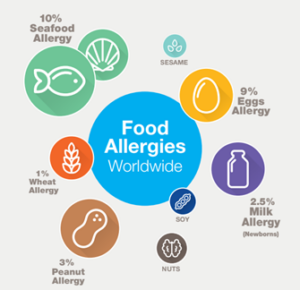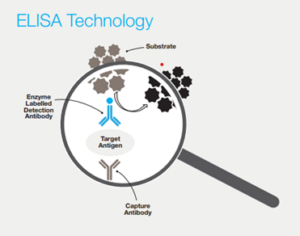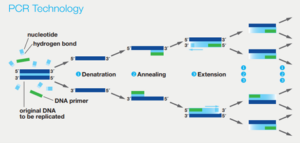Safeguarding Our Plates: Cutting-Edge Techniques in Food Allergen Testing
Last Updated on February 18, 2025
Food allergens are proteins that cause severe immune responses in sensitive individuals. With food allergies affecting approximately 2.5% of the global population, food allergen testing has become a critical tool to the field of food safety.
The rise in food allergies has increased the need for reliable and accurate detection methods. Recent advancements in analytical techniques, especially those related to protein and DNA detection have greatly improved allergen testing. These improvements have greatly boosted confidence in ensuring the safety of the food supply.
The Big 9 Allergens: Risks and Impact

Allergen Detection in Food Safety (Hygiena, 2010)
The “Big 9” food allergens namely – peanuts, milk, eggs, fish, shellfish, soy, wheat, sesame and tree nuts – are responsible for the majority of allergic reactions in individuals. These allergens can trigger reactions ranging from mild symptoms such as hives and itching to severe, life-threatening reactions such as anaphylaxis.
Reactions can occur within minutes of consumption and often require immediate medical help, which may be lifesaving. In individuals with allergies, the immune system mistakenly identifies these proteins triggering the release of histamine and other chemicals that cause symptoms. This immune response leads to the symptoms associated with allergic reactions.
Food Allergen Detection Methods: ELISA and PCR
The major methods used for allergen detection include Enzyme-Linked Immunosorbent Assay (ELISA) and Polymerase Chain Reaction (PCR).
Enzyme-Linked Immunosorbent Assay (ELISA)

ELISA Technology (Hygiena, 2010)
ELISA is a widely used food allergen detection method because of its specificity and sensitivity. This technique depends on antibodies for detecting allergenic proteins in food samples, through a series of systematic steps.
-
-
- Antibody Binding: ELISA plates are pre-coated with primary antibodies that particularly attach to the target allergenic protein, for example, peanut or milk proteins. These antibodies are made in such a way that they bind to the target protein in the sample if present in the sample.
-
- Sample Addition: When the sample is added to the plate, the target allergenic protein will bind to the primary antibodies and form an antibody-protein Only the target proteins will bind to the antibodies and form a complex.
- Secondary antibody: A secondary antibody, conjugated to an enzyme is introduced to the plates. This antibody-enzyme complex binds to the protein-antibody complex, which increase the sensitivity of test by amplifying the signal.
- Substrate Reaction: A substrate is added, reacting with the enzyme, eliciting a colour response that can be measured. The intensity of colour is proportional to the amount of allergenic protein present within the sample.
ELISA tests have high specificity, allowing detection of even trace amounts of allergens in complex food matrices. However, their effectiveness can be compromised by interference from other food components making meticulous sample preparation essential.
Polymerase Chain Reaction (PCR)
PCR is another method used for allergen detection, even in processed foods where proteins may be denatured. Specific DNA sequences from allergens can be identified using PCR, allowing for highly sensitive detection.

Polymerase Chain Reaction (PCR) ((Hygiena, 2010)
1. Sample Preparation: The food sample is homogenized and DNA is extracted purified to remove inhibitors that could interfere with the amplification process.
2. Amplification: DNA sequences are then amplified by specific primers characteristic of a specific allergen. These primers bind only with particular DNA sequences specific to allergenic sources.
3. Detection: Detection of the amplified DNA is done by real-time PCR, which allows for the rapid identification of the allergenic DNA.
Although PCR is highly sensitive, it can only identify allergenic materials rather than assess their immunogenic properties. As a result, it cannot detect the ability of the allergen rto cause an allergic reaction. This limitation makes PCR best suited for identification of contamination rather than assessing allergenicity
Best Practices for Allergen Management in Food Production
Allergen testing is integral part of the food industry. It ensures that the food is free from allergen before it leaves the production facility and compliance with regulations. Key allergen management practices in food production include:
- Raw Material Testing: Before entering the production facility, raw materials are tested to avoid cross-contamination. ELISA is particularly effective for detecting allergenic proteins in unprocessed and semi-processed foods.
- Cleaning Validation and Verification: These processes ensure that allergens are completely removed from production lines. ELISA is used during validation to ensure that cleaning methods are effective. Verification testing is conducted on-site to make sure that routine cleaning procedures have effectively removed allergen residues.
- In-Process Monitoring: Testing is done throughout food production, which aims to detect any potential allergen cross-contamination. Rapid testing methods, such as lateral flow assays, are used to provide quick results for real-time monitoring.
- Risk Management: Regular testing for allergens helps to detect contamination early, minimizing the risk of costly product recalls and loss of consumer confidence.
The Future of Food Allergen Testing: Innovation and Proactive Safety
Testing for allergens by methods such as ELISA and PCR is essential to the safety of food products. The number of allergen-related concerns is increasing, and meeting these consumer demands for allergen-free foods will require further advances in technology and testing protocols. Innovation and strict quality control will be key in maintaining consumer trust and protecting public health with safe products.
The future of allergen testing lies in precision, swiftness, and proactive safety. Emerging technologies, such as biosensors, merged with AI and machine learning, will be the catalyst in driving quicker, accurate allergen detecting systems that are truly automatic.\
Such advancement could one day empower on-the-spot tests for allergens, right at the point of sale, to minimize risks in real time. As the industry moves forward, the goal will be a paradigm shift from reactive allergen testing to proactive safety measures where food producers anticipate and prevent contamination before it occurs.



leave your comment